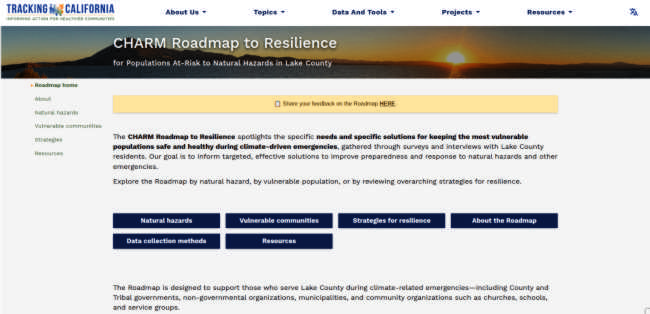
LAKEPORT, Calif. — After two years of community-driven research and collaboration, the Community Health Adaptation and Resilience Mobilization, or CHARM, project has released the Roadmap to Resilience for Populations At-Risk to Natural Hazards in Lake County.
This innovative online tool equips emergency planners and those serving the most impacted communities with insights and recommendations to better protect them against extreme heat, harmful cyanobacterial blooms, wildfires and other natural hazards.
The roadmap, now live on the Tracking California website, summarizes findings from over 230 community surveys and 65 interviews with county residents and includes practical strategies to reduce health risk from natural hazards like extreme heat and cyanobacterial blooms on Clear Lake.
Co-developed with Big Valley Band of Pomo Indians and four other Lake County tribes, community-based organizations and public agencies, the roadmap centers on the experience of elders, tribal members, outdoor workers, unhoused people, mobile home residents, people with mobility or transportation issues, and others often overlooked in traditional emergency response planning.
“By listening to community members directly, we’ve created a tool that not only documents the challenges Lake County faces, but also lifts up local knowledge and trusted solutions,” said Susan Paulukonis, principal Investigator of the CHARM project and epidemiologist with the Public Health Institute’s Tracking California program.
The CHARM project is a collaboration between Big Valley Band of Pomo Indians Environmental Protection Department and Tracking California, supported by the National Institutes of Health’s Community Engagement Alliance Initiative.
Building on the momentum of this roadmap, the CHARM team has been awarded a Phase II grant to implement a multi-year community-based intervention.
This next phase will pilot strategies to protect those most at risk during extreme heat, implemented directly through local sites such as peer support centers, senior centers and tribal social services offices across the county.
“We’re proud to build on this foundational work by turning plans into action,” said Sarah Ryan, environmental director for Big Valley and co-investigator of the project. “This project helps the most vulnerable members of our communities by reducing impacts of extreme heat and identifying lake water safety mechanisms. We now have a framework to guide targeted, community-led solutions.”
To ensure local input continues to guide next steps, the roadmap is being shared with the broader Lake County community throughout summer 2025, including presentations to the Board of Supervisors, the Risk Reduction Authority and at public events such as the Tule Boat Festival in July.
The roadmap remains open for feedback, and a brief evaluation form is available on the roadmap website for community members to share their input.
For more information, visit www.trackingcalifornia.org/projects/charm or contact Susan Paulukonis at

 How to resolve AdBlock issue?
How to resolve AdBlock issue? 



